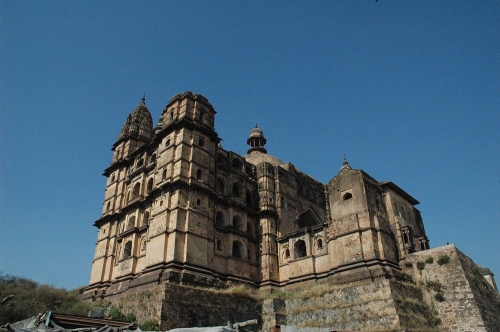The second chapter is an exploration of temple architecture at Brindavan, a newly settled Hindu sacred center that was at the heart of a novel Vaishnava religious movement, dedicated to the incarnations of the deity Vishnu. This site was located in proximity to flourishing urban centers of the newly established empire—Delhi and Agra—and could be accessed by the same transportation channels on the Jamuna River. The Gopinath, Madan Mohan, Govind Dev, Jugal Kishore, and Radhavallabh temples were built from approximately 1560 to 1620 at key sites in Brindavan, and in each case archaism and innovation played out against novel pictorial and literary representations. Such building projects received generous financial support as the imperial state oversaw and adjudicated their management and administration. For Hindu agents of a self-avowed cosmopolitan though Islamic empire, complex identities were balanced by drawing on the provenance of a sacred cartography at Brindavan.
The temples built at Amber, the family seat of the Kacchawahas (also patrons of the Govind Dev temple at Brindavan), are the subject of the third chapter. A relatively insignificant regional center before its incorporation into the Mughal sphere, Amber was systematically reshaped during the late 16th and 17th centuries to emulate trends in Mughal urbanism. A new shrine, the Jagat Shiromani temple, was built in 1600 alongside a mosque, also constructed and patronized by the Kacchawahas. Older shrines in Amber retained connections to familial, mythical, and place-based histories and to a local cartography of sanctification. At the end of the 17th century, another shrine, the Bihariji temple, was built in a climate of shifting politics, as archaism and innovation were tuned to altered valences. Throughout, Amber remained a seat of familial and clan identity and, therefore, a site of power as well as anxiety.
The fourth chapter takes the discussion to another regional capital, Orchha, controlled by the Bundela family. Unlike the Kacchawahas, the Bundelas were relatively new entrants to North India’s register of ruling elites. As their territories were incorporated into the Mughal imperial system during the early 17th century, the Bundelas enhanced Orchha to conform and compete with contemporary fashions in architecture and urbanism. The Chaturbhuj temple, completed in the 1620s, towered over the town with its tall shikara and lofty, vaulted ritual hall. Construction of the Laxminarayan temple and a palace, the Jahangiri Mahal, also began at this time. These edifices were part of an ambitious, citywide building program. Architecture, painting, and literature were drawn into service as Bundela domains were simultaneously forged as a regional kingdom and a province of the Mughal Empire.
At each site, cultural inheritance, lineage and clan histories, and mythologies were crucial, as were notions of territory and regional culture. During my fellowship, I built upon previous archival research and on-site architectural investigations of sites and temples. I studied critical editions of familial and clan histories as well as religious texts, examining paintings in museum collections alongside my own photographic documentation, to build a palimpsest of visual and textual evidence. Conversations during colloquia and research circles have helped me to fine-tune arguments as I engage Mughal creativity and aesthetics across several media and materials. Questions of history, identity, and historicism will remain at the heart of my research on Mughal temples and their architecture.
The Pennsylvania State University
Ailsa Mellon Bruce Senior Fellow, 2020–2021
Madhuri Desai will return to her position as associate professor of art history and Asian studies at the Pennsylvania State University.


